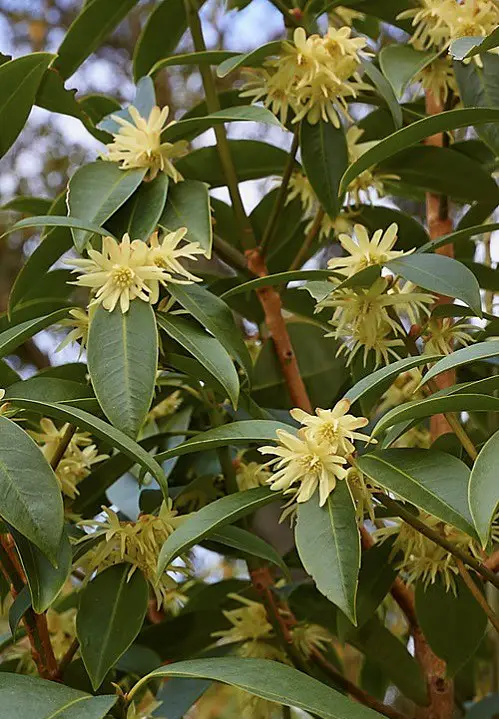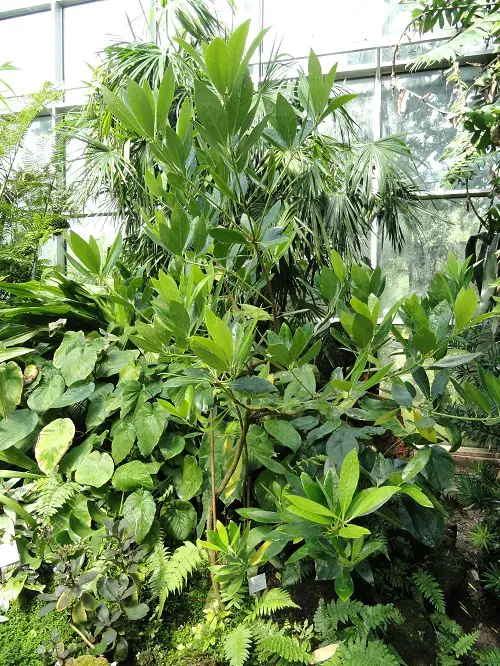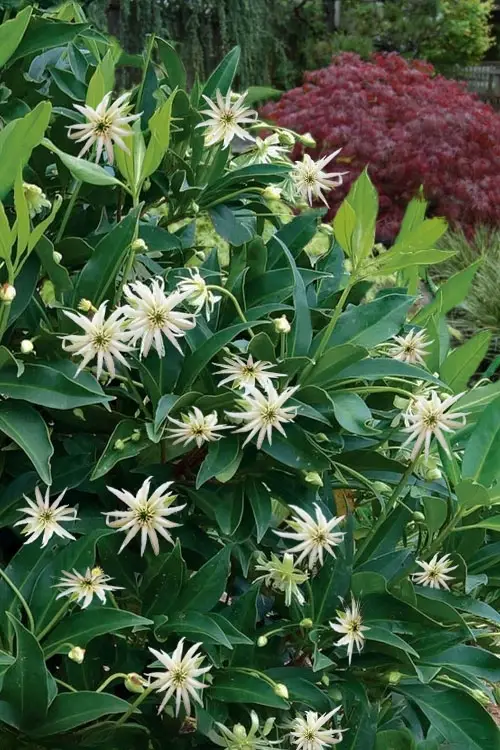Learn how to grow Star Anise and enjoy an unlimited supply of this flavourful spice in your home garden!
Star anise is a spice widely used in South East Asian cuisines. Easily grown in tropical regions, the plant is adorned with beautiful flowers and star-shaped fruits. If you love its earthy flavor, Learn How to Grow Star Anise in this informative article!
Star Anise Plant Profile

With its roots in South Eastern China, 80-90% of the world’s production is indigenous to China and is now produced in Laos and Vietnam. In India, it is produced to a small extent in Arunachal Pradesh. It is mainly cultivated for commercial purposes and exported to various parts of the world. Star Anise grows best in subtropical regions and needs to be nourished in greenhouses in cold regions.
The tropical evergreen tree grows up to 15-20 feet tall. It features large, glossy green foliage, and the white flowers are beautiful and of great decorative value. The fruit has eight carpels forming the star shape, hence the name.
Botanical Name: Illicium verum
Other Names: Anis de Chine, Anís Estrellado, Anis Étoilé, Anis Étoilé Chinois, Aniseed Stars, Anisi Stellati Fructus, Ba Jiao Hui, Badiana, Badiane, Badiane de Chine, Bajiao, Chinese Anise, Chinese Star Anise, Eight-Horned Anise, Eight Horns, and Illicium verum.
USDA Zones:8 – 11
Difficulty: Moderate
Star Anise Propagation
Star anise is propagated by seeds or cuttings. Seeds are propagated best when the temperature ranges from 65-70 F (18-20 C). As the seeds do not appreciate transplantation, you can directly sow the seeds in the pot or the garden.
Seed propagation is a time-consuming process, so you can consider buying a well-grown plant from a nursery and nurturing it at home.
Water the seeds frequently to keep the soil moist and ensure the pot has enough drainage holes in the bottom to drain excess water.
If growing from cuttings, snip a 5-6 inches healthy hardwood stem near the leaf node, scrap the ends, and plant it in a blend of peat moss, perlite, and sand. Water well, a,d provide ample sunlight.
Choosing the Right Pot

You need not worry if you don’t have an extensive garden. Star Anise does pretty well in pots. Start the seeds in a 12-14-inches pot. Transplant it to a bigger pot once you find the roots spreading out of the drainage hole.
If you have bought a plant from a nursery, then move it to a one size bigger pot than the current one. Do it once the plant has acclimatize your environment.
Requirements for Growing Star Anise

Sunlight
Star anise requires dappled shade and partial sun, but plant it in a warm and sunny location if you’re growing star anise in a cooler climate. Choose a position so it is not exposed to cold and dry winds.
Also, keep the plant away from the harsh afternoon sun that might burn its leaves.
Soil
Star Anise needs a well-draining medium that is slightly acidic. If you are growing it in pots, the ideal potting mix would be a blend of peat moss, river sand, well-rotted manure, and a handful of perlite.
The plant grows really well between a pH of 6.0 to 7.5.
Watering
Water the soil around your star anise in the morning once the top 2 inches feel dry. This applies to both potted and in-ground plants. Keep the soil moist but not soaked between waterings. Aim to provide at least 1 inch of water each week. Using drip irrigation is an excellent way to get water straight to the roots. In winter, reduce watering, as the soil won’t dry out as quickly.
Temperature & Humidity
It prefers a warm subtropical climate with high humidity. It is vulnerable to frost and does not survive in areas with temperatures below 15 F or -10 C. The ideal temperature range for growing star anise is between 68-95 F (20- 35 C).
Star anise trees grow best in the southern United States, in zones 7 through 9, where they experience hot summers and mild winters. In hot weather, star anise trees thrive without issues—just remember to water them as needed.
If you live in a cool area below USDA Zone 9, plant star anise in a container and keep it in a greenhouse or indoors in winter. A humidifier or an external heat source should also help the plant survive.
Star Anise Care

Fertilizer
If you have amended the growing medium with plenty of organic matter, don’t worry much about feeding the plant. To boost growth, use aged manure or compost once a month. You can also use a balanced liquid fertilizer diluted to 1/4 of its strength once every 4-6 weeks.
Pests and Diseases
There are not any specific pests or diseases that bother it. Star anise itself has antibacterial and pest-repellent properties. However, it might occasionally get contracted by fungal infestations like Alternaria Blight or Downy Mildew.
Snip away the affected stems and use an insecticidal soap solution to fight the diseases. Avoid overwatering to bar further infestation.
Pruning
To keep your star anise growing as a nice shrub, prune the tips in winter. Use sharp shears and cut no more than 6 inches off each branch. Avoid electric tools since they can leave branches and leaves looking rough. Trim any weak or diseased branches as you see them.
Pruning star anise doesn’t need any special steps, and you don’t have to worry about the pods—they’re picked while still unripe. Keep it well-trimmed, and you’ll see why people love these trees for their beauty.
Harvesting Star Anise
When you see rounded pods on your star anise plant, cut them off individually with garden shears and dry them in the sun. Once fully dried, they will change from a rounded shape to star-like points, earning them the name “aniseed stars.” The pods also turn from green to reddish-brown. When the pods open, the seeds inside are ready to flavor dishes. To check if they’re mature, take a seed and pinch it. If it smells like black licorice, it’s ready. If not, wait a few more days and try again until you get that licorice scent.
Storing
To store star anise seeds once they’re out of the pod, use airtight containers. If you keep the seeds in the pod, they’ll stay fresh for up to two years for cooking. Ground seeds last up to one year and can even work as a pest repellent. If the seeds lose their strong aroma, they’re no longer good and should be discarded.
Star Anise Uses

The flavorful spice adds a rich aroma to meat dishes, stews, soups, broths, and other savory dishes. It is also used in desserts and beverages. It is an essential part of Chinese cuisine and is used in various South-Asian cuisines.
Together with fennel seeds, cloves, cinnamon, and pepper, it is considered one of the “Five Chinese Spice”, used for its strong taste and spicy flavor. Apart from its culinary uses, the spice also exhibits several pharmacological benefits.
Warnings
While growing star anise, don’t confuse it with Japanese star anise (Illicium anisatum) or Shikimi, a poisonous plant native to Japan. Shikimi’s seeds or fruits are somewhat similar to those of star anise but only slightly smaller. They look like cardamom with a rounded shape and a small hook.






Informative. I have a terrace garden and want to grow. Where can I get the seeds or sapling
Just buy a pack of star anise from Indian grocery store — it has lots of seeds
But in this article they have clearly mentioned that the green flowers are dried to produce star anise.
Meaning the seeds are not fully matured.
But we must keep trying to find matured seeds from these dried flowers (usually seeds don’t give flavor)
Very informative with exciting balcony gardening.
Star anise smells amazing. We have a Ocala Anise that is very similar to this plant but not edible
please provide a photos to help distinguish real star anise [good] from Japanese star anise and swamp star anise [poisonous!]. All three are mentioned in this article.
The photo is already shown above for the real Chinese Star Anise.
Despite the warning, the article mentions the WHITE flowers, which produce the poisonous fruits.
Illicium verum has pink to red flowers, petals form in a whorl in which they stay.
Hi, do you plant the whole dried flower please? My husband bought a jar of star anise from the grocers. I haven’t the heart to tell him it could take 6 years if I’m successful! Cheers and thankyou, Marilyn,
How many stars per plant can I expect to harvest?
Where in Kerala is sapling of illicium verum (star anise) availble?
Where can I buy the star anise seedlings in Nairobi Kenya? The ones that are ready for transplant.
Bonjour , Ou peut on commander un pot d’Anis étoilé badiane illicium verum ou des graines qui sont fraiche et qui germent car dans les magasin elles sont toutes étuvé ou seche et ne germent pas …..des centaines de tentatine de faire germer ont échouées…..ou peut ont trouver des graines fraiches ? merci
Are 2 plants needed for fruit?
Where are these plants and seeds available?
8523056984
Avez vous encore des graines Anis Étoilé (Illicium verum) FRAICHE et viable pour un semi ? pour les semer ….?
merci de votre réponse